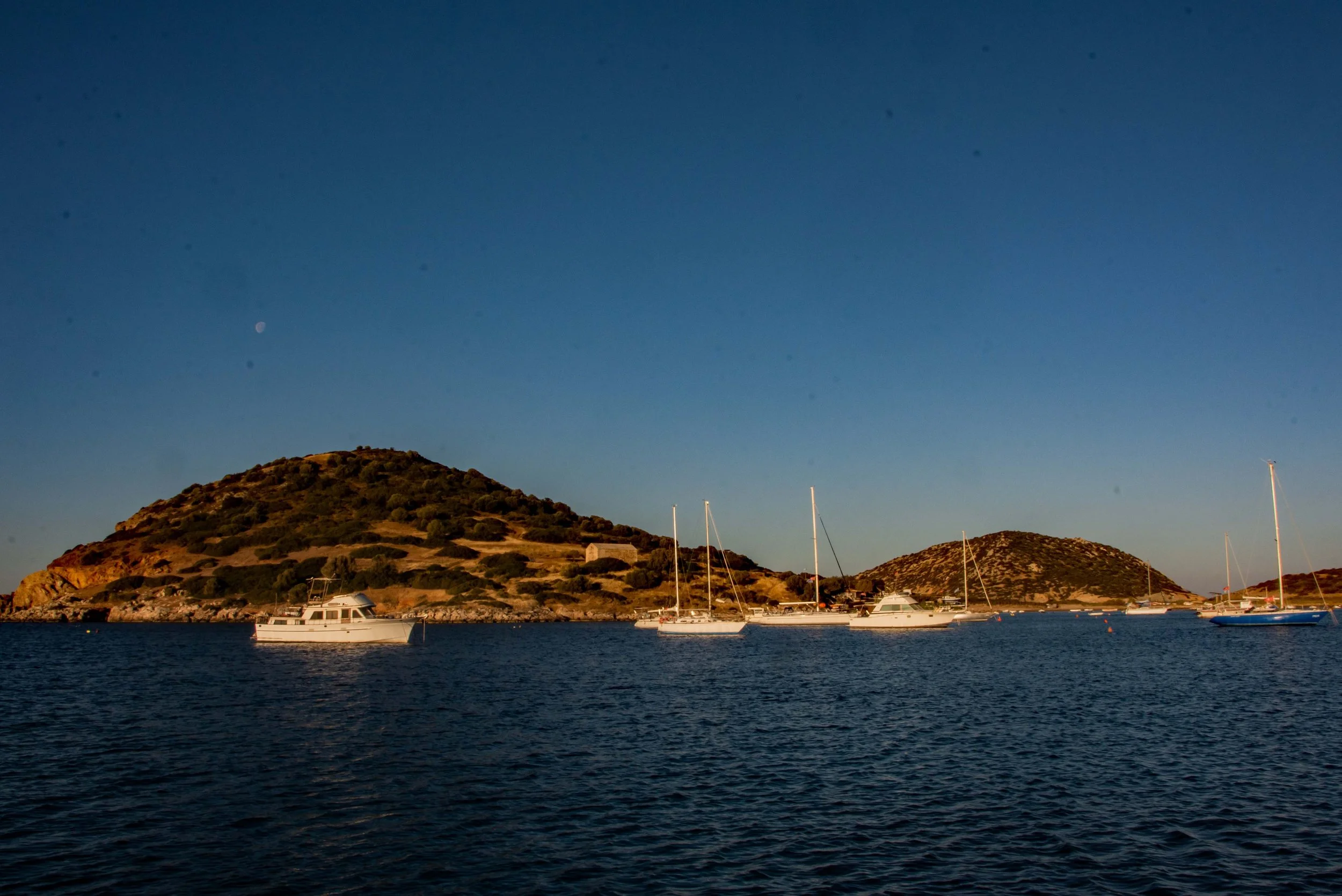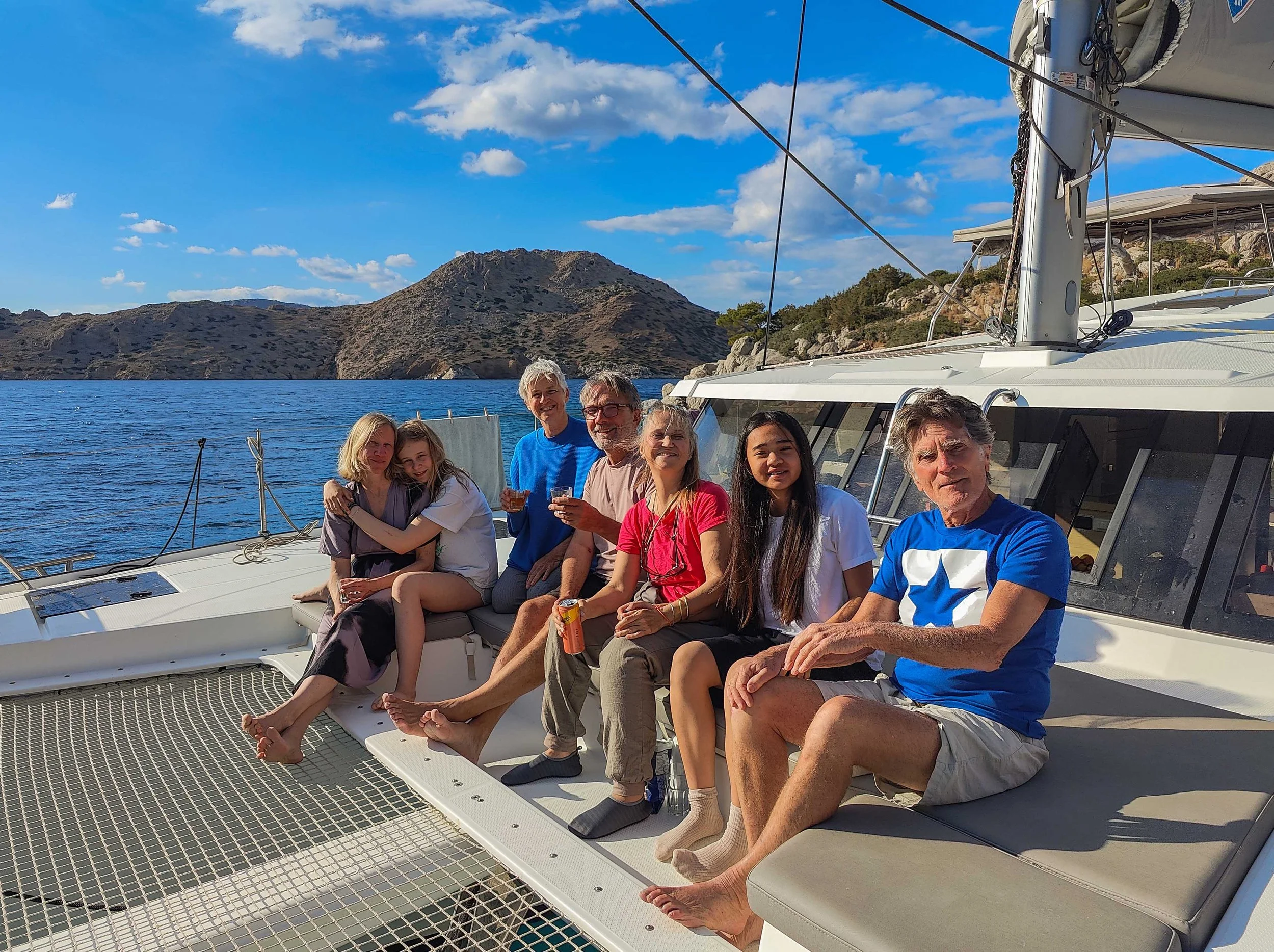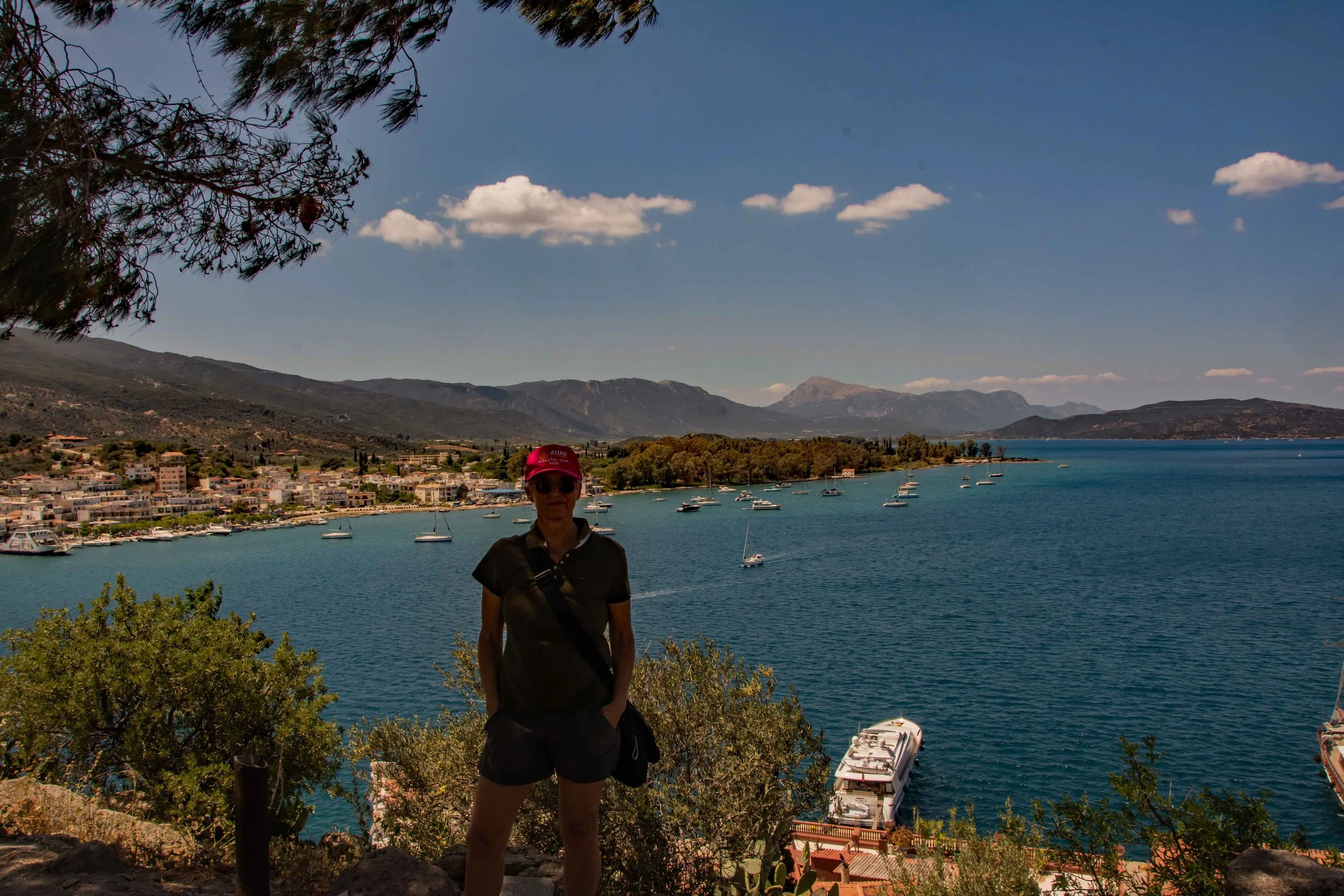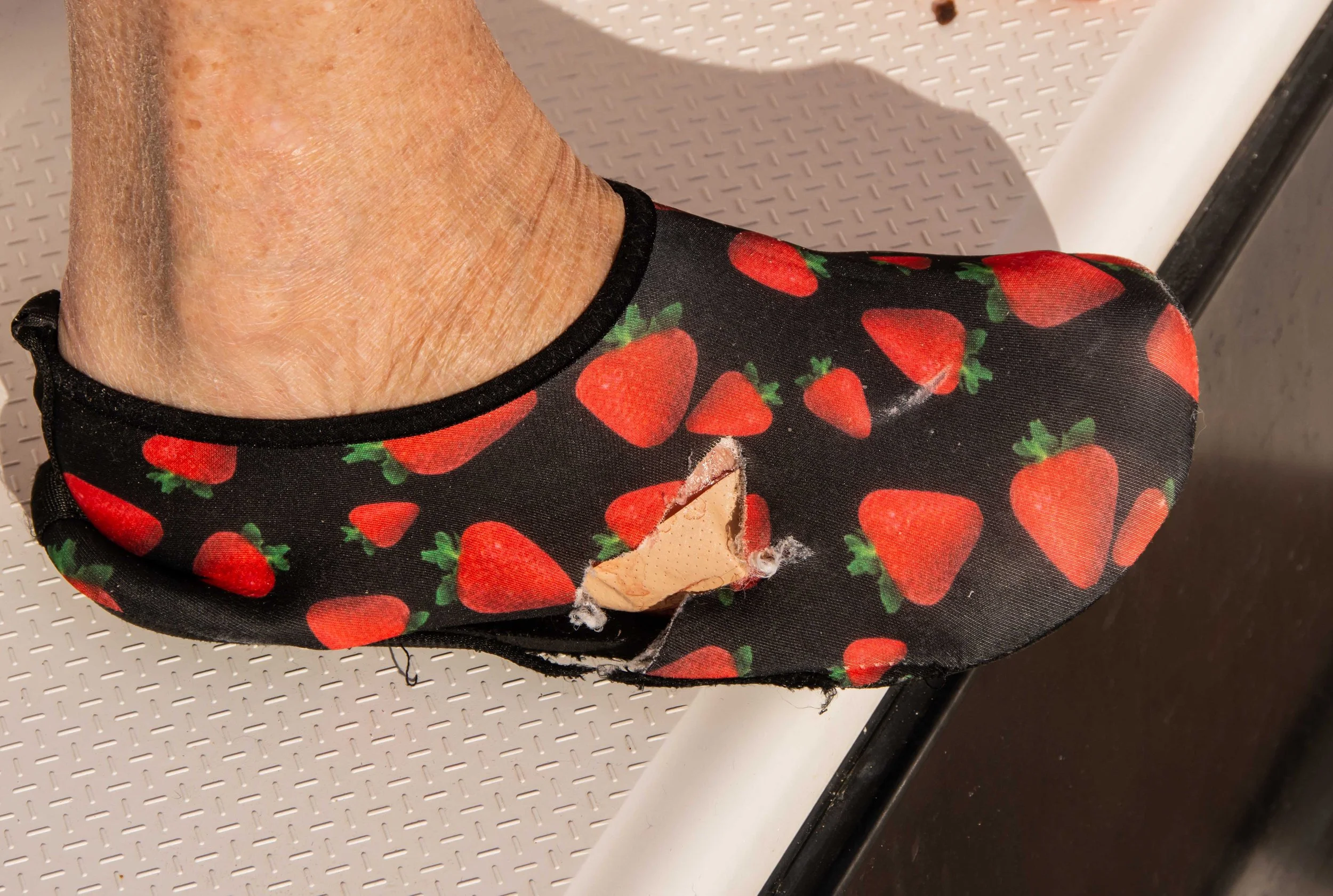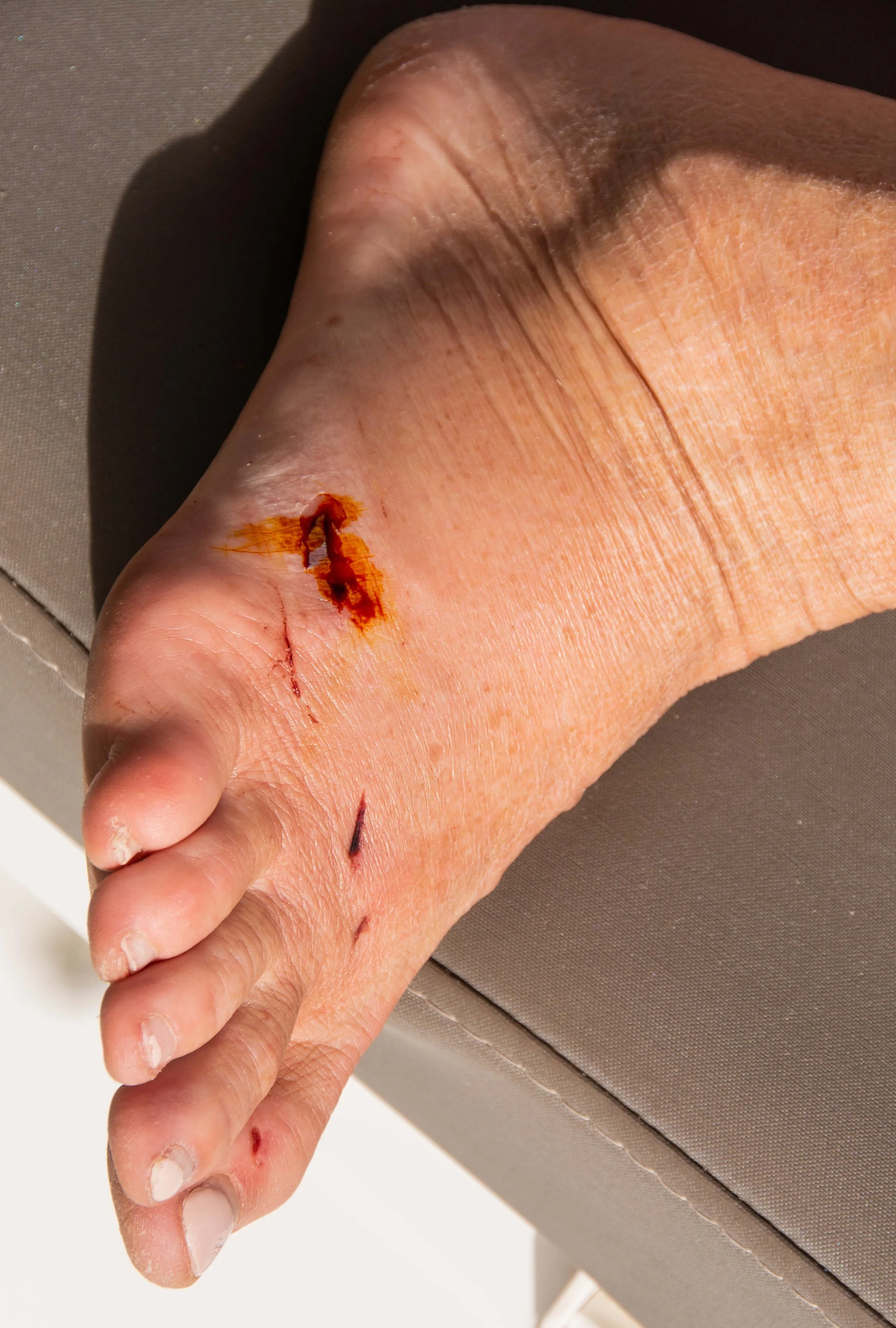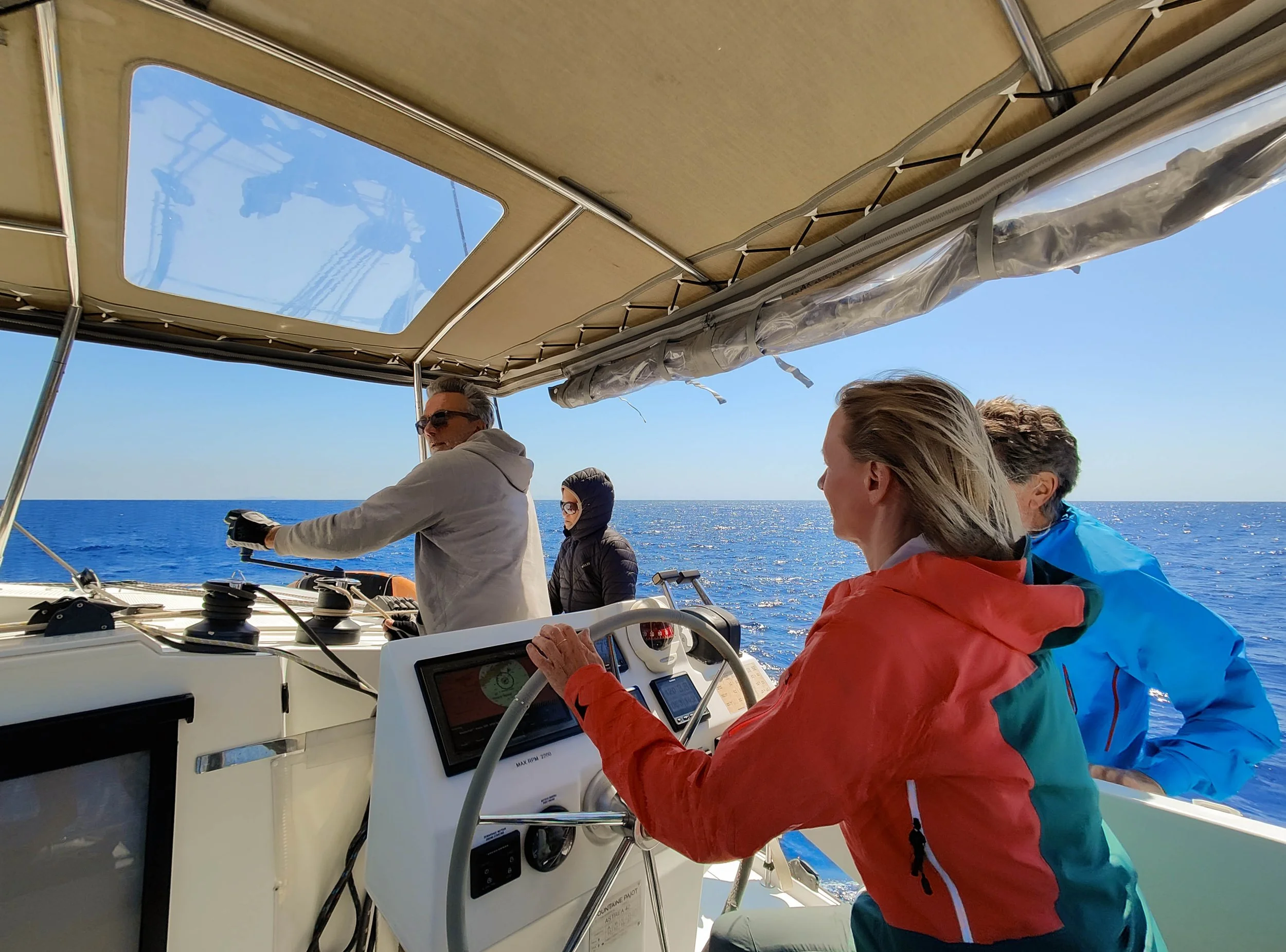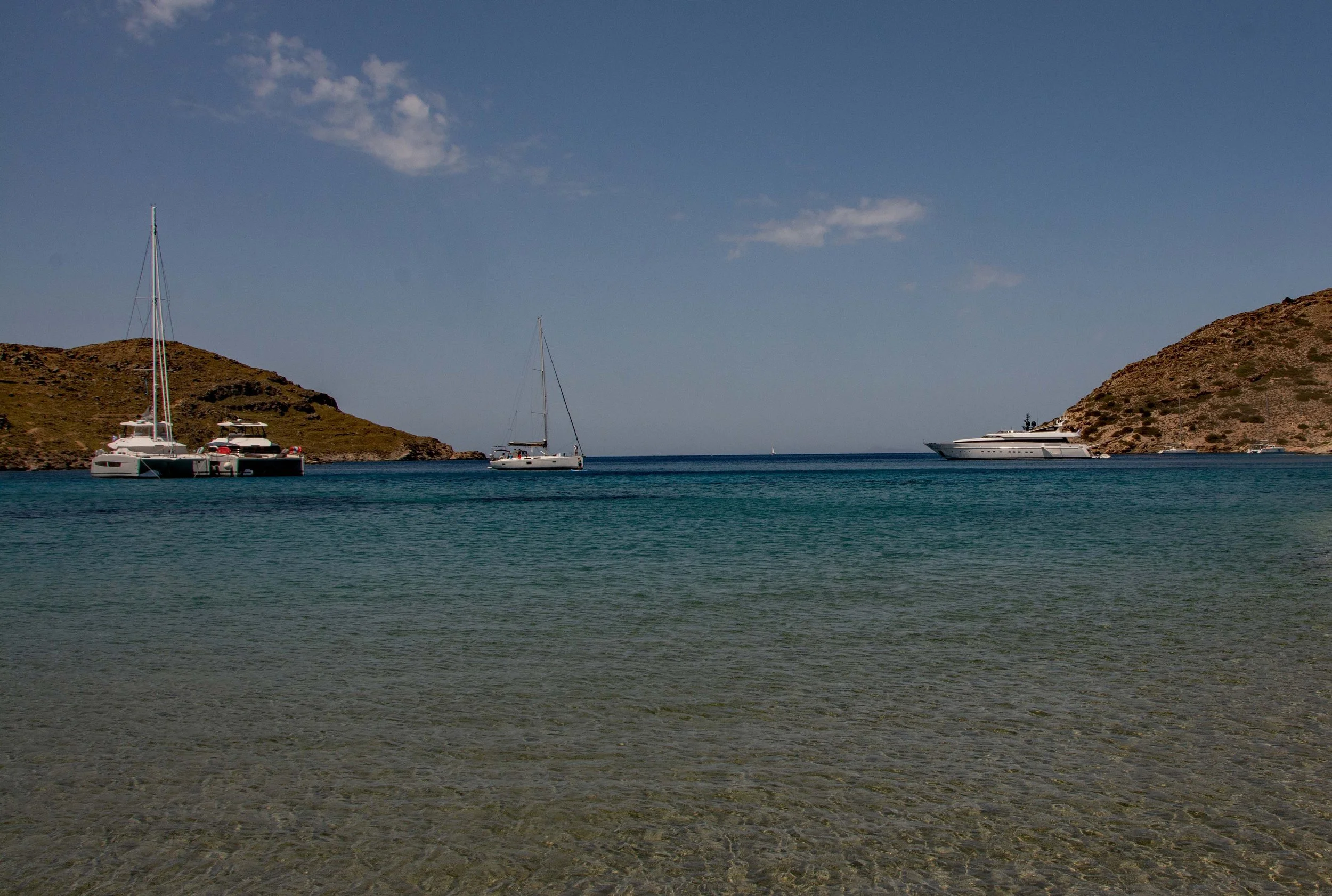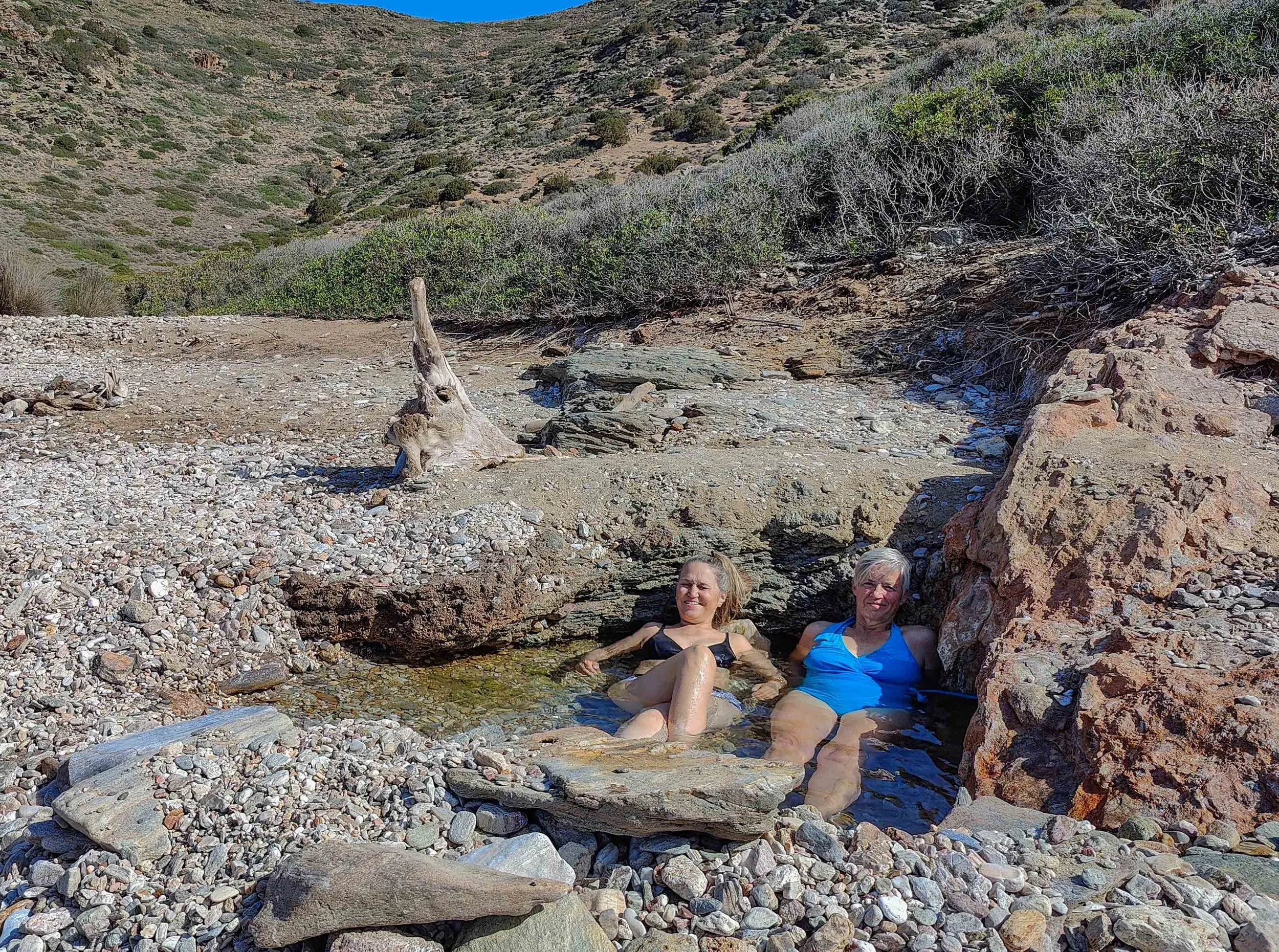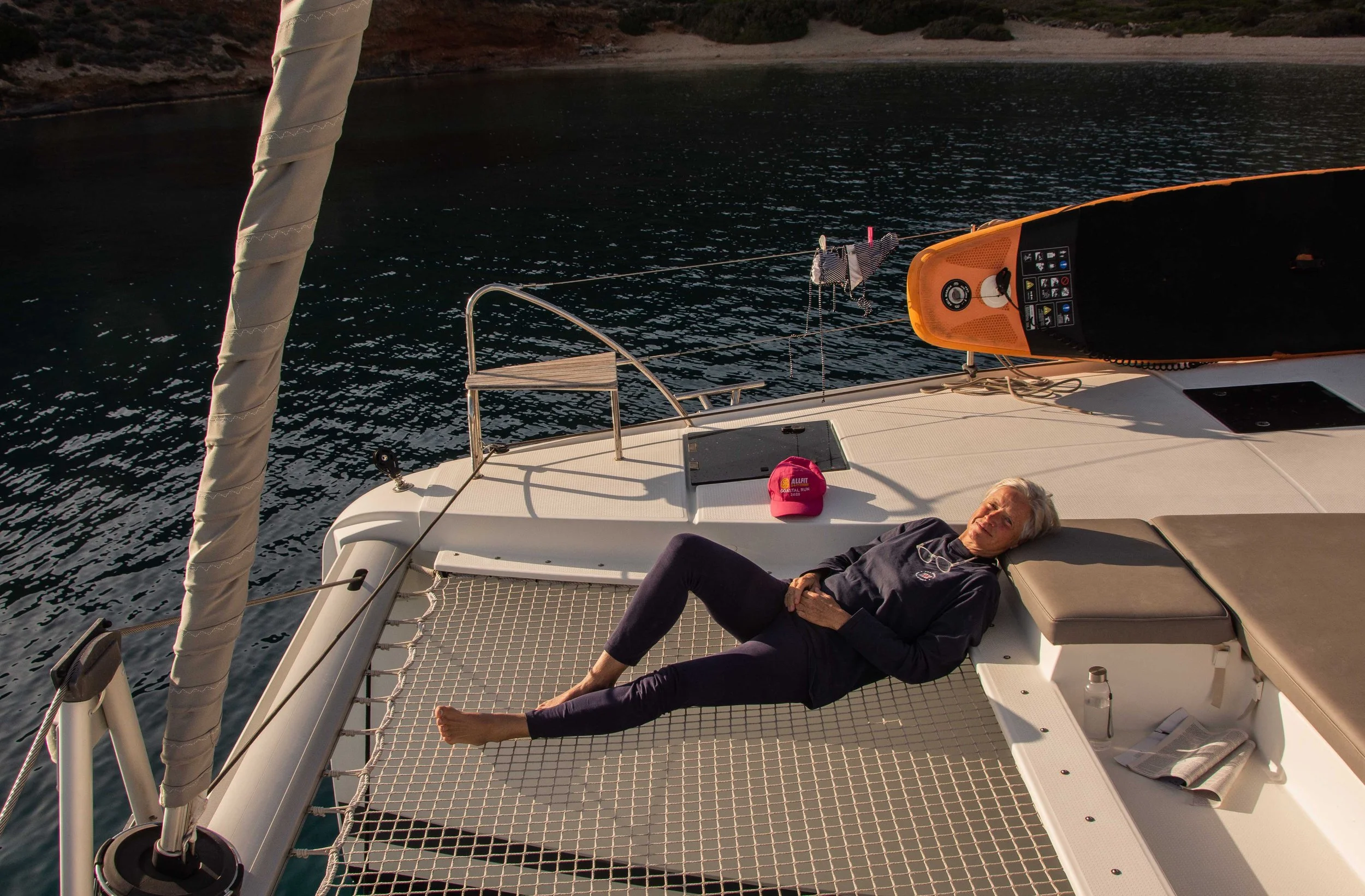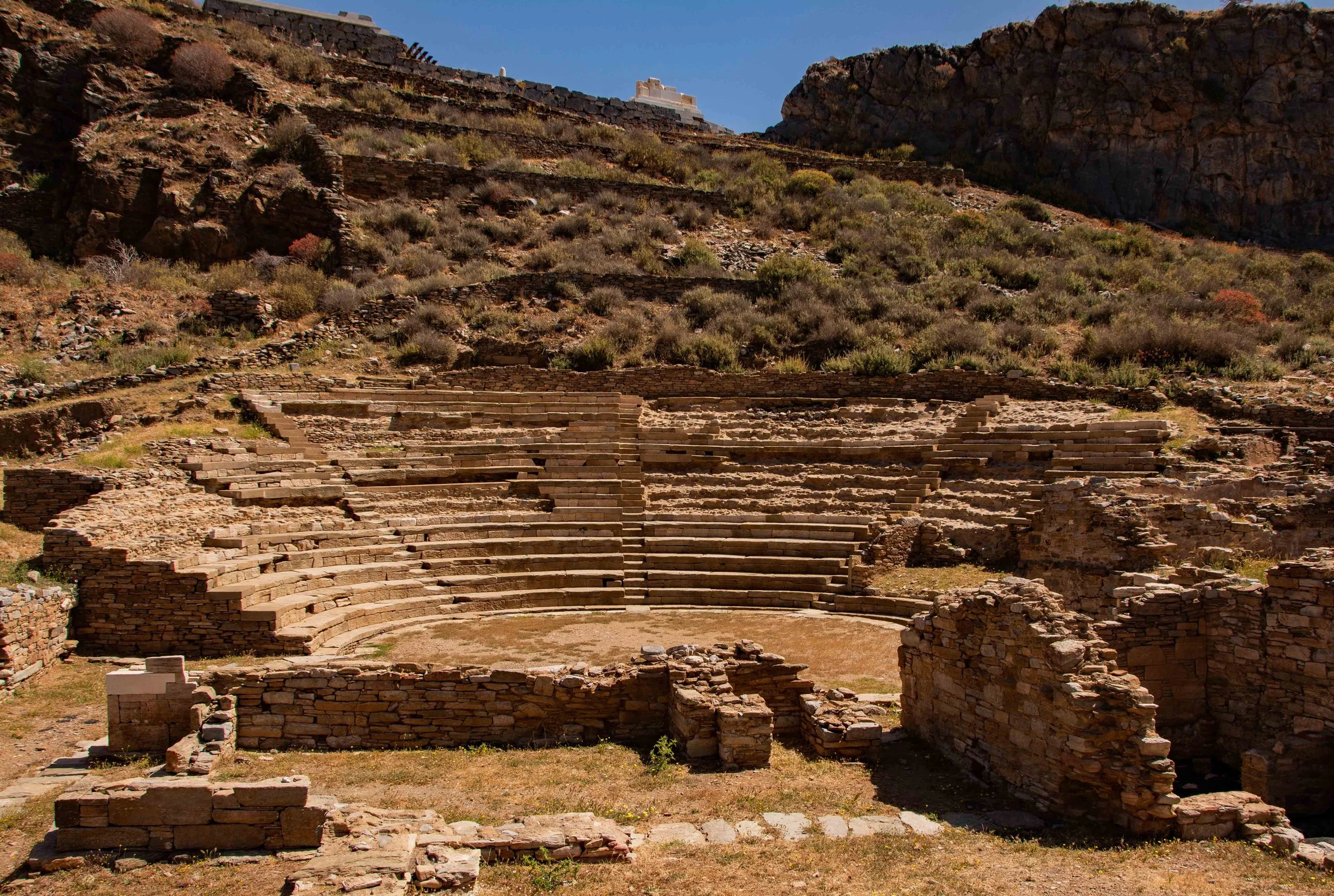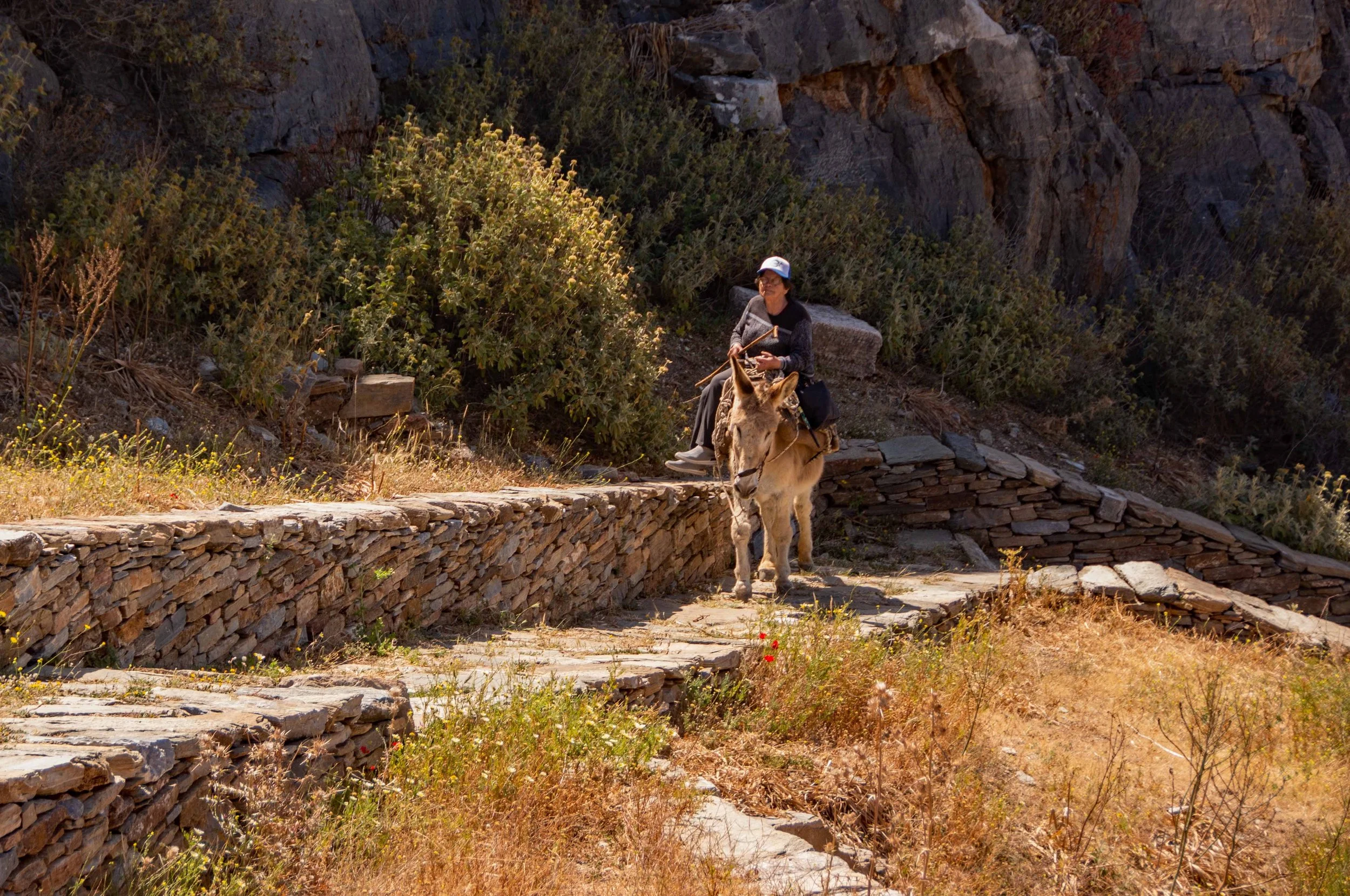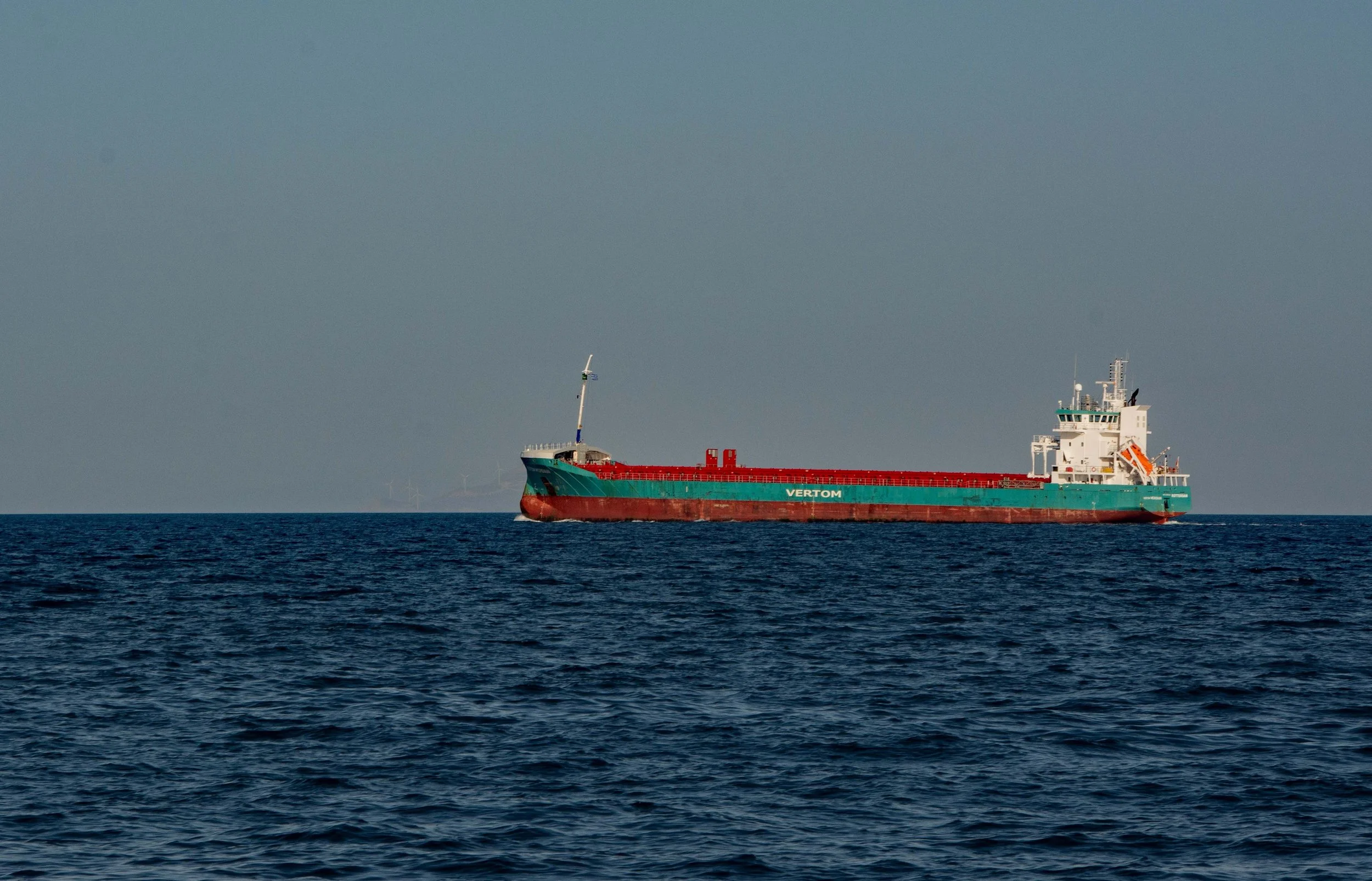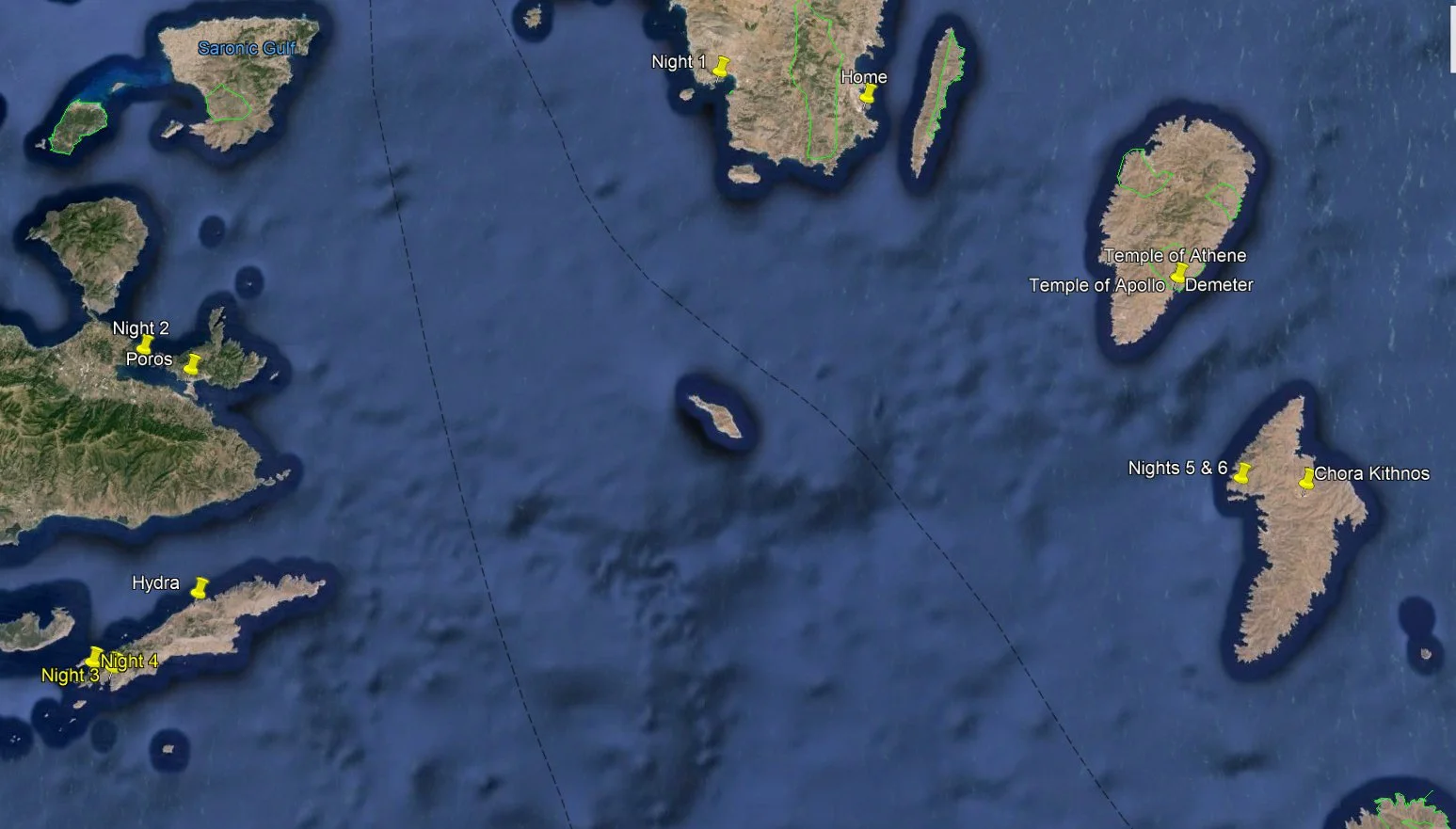Friends of ours had booked a sailing trip in the Aegean, something they have done in previous years. One couple had to drop out and Ursula was asked if we would like to take their place. Would we just! The timing fitted in perfectly with Ursula’s work plans. She had to travel to Ukraine for a work visit and so was able to fly directly from Ukraine, via Warsaw, to Athens. I flew from Geneva and we met up in Athens Airport on 26th April and went straight out to the catamaran.
A word on the organisation; The catamaran, the Wild Baleine, was hired by Reto and his wife Kristina, friends of the other participants. Reto and Kristina live in Greece and Reto has wide experience of sailing in the Aegean. The other members of the group were Esthi and daughter Hanna, and Kathrin and her daughter Maelle. With Ursula and me that made a crew of 8.
Photo 1. Ursula and me arrived in the dark and this was what greeted us on our first morning, still at anchorage and waiting for Kathrin and her daughter to arrive.
We woke on the boat at the mooring waiting for the last member of our crew to arrive, Kathrin and her daughter. Skipper Reto went to the shore to bring them back to the boat in the Wild Baleine’s dinghy.
Photo 2. The crew of the Wild Baleine assembled on deck, missing Kristina who was taking the photo.
We left the harbour with fairly strong winds, force 5 (31 – 39 km/h) gusting to force 8 (51 – 61 km/h) and predicted to increase over the coming days. This led to a change of plans. Reto intended to sail South and East to the Cyclades and explore the islands there. However, the weather conditions meant that we sailed to the West.
Passing by St. George’s Island to the South with several windmill generators along its ridge, we crossed the Saronic Gulf to a lovely bay where we anchored and overnighted. There we were well protected from the North winds.
Photo 3. First overnight in what was the first of a succession of lovely protected bays where we overnighted. Reto and Kathrin facing the camera.
Monday, Day 2
In the morning we weighed anchor and made the short journey to the island of Poros. Weighing (raising) the anchor is an undertaking requiring clear signaling and good coordination. So as not to put too great a strain on the electric winch, the yacht slowly motors upwind as the chain is winched on board. However, it is important that the yacht moves straight up on the anchor, and with the wind swinging the boat, one crew member stands up front signaling which way the boat is swinging so that the helmsman can bring it back on line again. Meanwhile another crew member is watching the chain piling up in the hold to make sure that it does not interfere with the winch. We were tested at first, but with practice, we soon improved. Ursula and Esthi made up the anchor team with assistance from others when needed.
Photo 4. Sailing into Poros a beautiful calm morning. The sea really is an astounding blue.
We did a little shopping and general sight-seeing, exploring the town of Poros for several hours. From there we sailed on to an overnight anchorage. The wind was mild in the morning but the forecast was for it to increase a lot in the afternoon.
Photo 5. The anchorage at Poros, our catamaran the Wild Baleine is the closest boat
Ursula and I spent time exploring some of the back streets and arrived at the church at the top of the hill over-looking the port.
Photo 6. Overlooking the port of Poros.
We left Poros in the early afternoon, just as the wind, as predicted, was picking up. We sailed first south then west through the channel separating the island of Hydra and Poros. Rounding the tip of the island of Hydra we made anchorage in another beautiful and protected bay. Night 3 on the map at the end of the blog.
Photo 7. Second night anchorage, on the southern coast of the island of Hydra, well protected from the north wind.. Wherever we went we found the water quite deep right up to the shore.
Day 3 Tuesday
The next day we sailed back to the port of Hydra. Here the small harbour was packed with boats with other boats queueing at the entrance for a chance to enter and disembark. We went on to a nearby bay and tied up there, and took a water taxi back to Hydra.
Photo 8: The town and port of Hydra, beloved of Leonard Cohen
When tying up Ursula swam ashore with one of the stern ropes and then swam back to the boat to collect the 2nd rope. As she clung on to the back of the boat her legs were sucked under by the wash of the propellors. The propellor sliced through the beach shoe Ursula was wearing, nicked the big toe on her right foot, a slightly larger nick on top of the foot, and a larger nick on the outside of the right foot. Oh, so very lucky. Half a centimetre further and Ursula might have lost her foot. This left us all feeling a bit shocked at what might have been.
Photo 9. Ursula’s shoe sliced open showing just how lucky she was. We already had a Band-aid in the wound.
Photo 10. Three nicks across her foot. Another cm and !!!
Once Ursula’s foot had been ministered to we set out to explore Hydra. Hydra is a charming little town. No motor vehicles, except for essential services, are allowed on the island, so transport is mostly donkey work, with a few horses. Hydra also has the claim to fame that Leonard Cohen lived there during the 1960s, and it was there that he met his lover, Marianne Ihlen, commemorated in several songs including So Long, Marianne.
Photo 11: No private vehicles on the island, so donkeys provide most transport
Ursula and me wandered the backstreets and came across this little church. We found a man carrying a number of cases of water into the church. After he went inside with the first two, we carried the rest and left them on a table outside the church door. Ursula helped herself to a couple of lemons from the tree as recompense.
Photo 12. The church with lemon tree visible on the left
Leaving Hydra we sailed to a small inlet we had passed on our way to the port. The previous night we had noticed a boat moored there and it seemed to offer a beautiful spot to spend the night if it was empty. And to our delight, it was. A small bay with a little chapel almost on the water’s edge.
The water here, as everywhere we went, was crystal clear and even in quite deep water the bottom was clearly visible. However, this apparent cleanliness was dispelled when Ursula went for a snorkel and using goggles, she reported that the bottom was littered with rubbish, presumably discarded by yachts anchoring there.
Photo 13. A lovely little bay with this picturesque chapel offering good protection from the northerly winds.
We had noticed that several offshore rocks / tiny islands had small chapels built on them. I do not know what the function of these are, perhaps they are hermit’s cells, but a more likely explanation may be that these are built by families to commemorate the death of a relative, perhaps foundering on the rocks of the islands.
Day 4, Wednesday
On day 4 was to be the longest leg of the trip, an estimated 8 hour crossing across the straight to the bay of Ormos Kolona. The day started well with the wind a gentle 15 – 18 knot (28 – 33 km/h) wind and mild seas.
Photo 14: The day started quietly, this was not our yacht, but similar.
Reto took control of the helm coming into port and other more challenging manoeuvres, but once on the open sea Reto allowed crew members to take the wheel and steer the Wild Baleine. Keeping on a heading in the strong winds and white-topped swells was an “interesting” experience, but we all improved our abilities as we gained experience.
Photo 15. Kathrin at the wheel, Reto on the winch
However, it was predicted that by midday the wind would be 45 +km/h, with seas of 1.5 metre, but that it would drop later. In fact, the wind increased as predicted, and then rose further and never dropped.
Photo 16: The weather rapidly livened during the crossing.
On the boat we recorded winds of over 30knots (56km/h) with some swells definitely over 1.5 metre. As a result, we spent most of the day under motor as we wanted to reach our destination before dark. We did reach anchorage after sunset but before dark. We had a couple of hours under sail at the start of the day, but the conditions and time constraints meant that most of the day was spent motoring into the swells. We had a sighting of dolphins but the rough sea meant that the sighting did not last very long.
Conditions were difficult and several of the crew were seasick. One of the things about seasickness is that the moment you reach calm water the feeling of seasickness disappears. Those who felt that they might never eat again were soon wolfing down their dinner once we arrived at our destination, the Island of Kythnos. The crossing took nearly 9 hours in the end.
Day 5 Thursday
Photo 17. Our anchorage on the Island of Kythnos. A narrow entrance gives good protection to the inlet.
The catamarans on the left are of similar design to the Wild Baleine, the mega-yacht on the right is one of several oligarch type vessels we saw in every port. The beach of the bay has a hot spring and some of us spent the day relaxing and swimming.
Photo 18. Esthi and Ursula taking advantage of the warm water spring on the beach.
Others of us went ashore and took a taxi to the village of Chora Kithnos. It is a typical small Greek village of white houses and shops. It has a population of 900, but this swells to thousands during the summer and important religious holidays with people coming in from the mainland. It is just over 50 km from Athens and so is a popular destination.
Photo 19. Chora, the capital of Kythnos, strung out along the hilltop. Every building a dazzling white.
The houses were all freshly painted for the Orthodox easter and were startlingly, blindingly, white. Those of us who went to the village enjoyed a lunch of cool white wine and grilled calamari.
Photo 20. And the inevitable donkey transport on the main street of Chora.
Photo 21; Relaxing after a hard day.
After our sight-seeing we spent a second night at Kythnos, leaving early, (for us) the next morning
Photo 22. Dawn at Kythnos.
Day 6, Friday
Leaving Kythnos we sailed to the nearby island of Keos, (also known as Kea) where we moored and visited the ruined temples on the island. There is a temple to Apollo, although the statue of Apollo that stood there disappeared around 1811, a temple to Athene and an amphitheatre dedicated to Demeter.
Photo 23. Temple of Athena, built circa 500 BC. The floor has been covered for protection
Photo 24. Temple of Athene with Maelle and Hannah.
Photo 25. Demeter’s amphitheatre. It could seat 2000 people. The temple to Athene just visible as the white structure at the top of the hill.
It is amazing to discover that 2500 years ago this dry smallish island of dry land was a wealthy and powerful city state. What will London, Berlin or New York look like in 2500 years’ time?
A church has been built on the shores of the bay and we met this woman, on her inevitable donkey, returning from cleaning it in preparation for the Orthodox Easter.
Photo 26. Donkey work. Something symbolic here, with Easter looming.
Photo 27: Ursula and Esthi, overlooking the Wild Bailene anchored in the bay. Again, look at that fabulous blue water
Before we left, we had a last swim and dip in the warm spring.
Photo 28. A last swim, the temples just visible on the hills behind.
From there we sailed to our home port, the wind very strong and some commercial traffic from Piraeus.
Photo 29. A busy sea route. The passage-way is fairly narrow and it is one of the places where sail gives way to power.
After a bit of difficulty refuelling, my fault I’m afraid, we moored and spent our last night on the boat. However, we did go out for a simply wonderful seafood meal, fish, squid, mussels and other local ingredients.
Photo 30 Home marina, image from Google.
The next morning, we said goodbye to Esthi, Katherin and their daughters. Ursula and me were flying the next, Sunday, morning, and we stayed overnight in a hotel on the coast. However, we did have another wonderful seafood meal with Reto and Kristina, only slightly marred by the unseasonal rain.
A truly wonderful holiday and one we are determined to repeat next year, if at all possible. Maybe later in the year late September for better weather?
Photo31. From the log of the Wild Baleine showing the route. 162 nautical miles is almost exactly 300 km, the distance travelled.
Photo 32: From Google earth showing the main places along the route.
A special thanks to Reto and Kristina for a wonderful time and the delicious meals prepared under difficult conditions. I have been told that next year it will be my turn in the galley. Meal standards can only decline.
